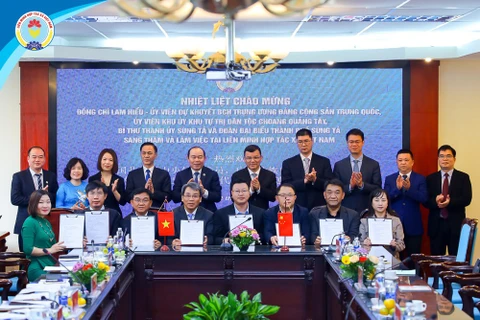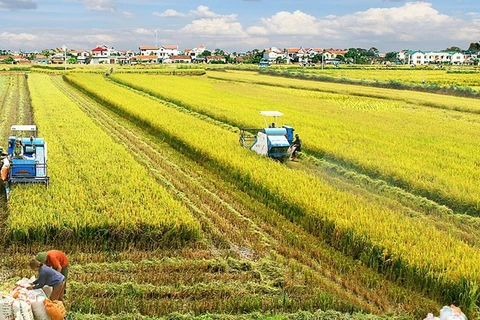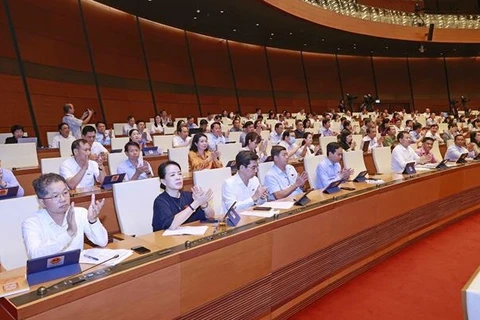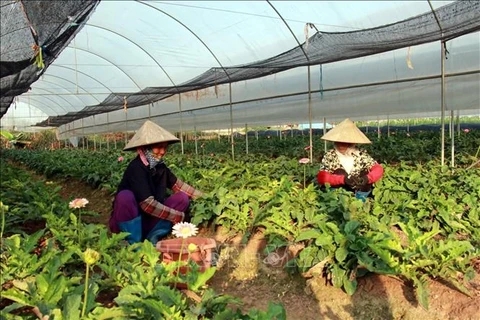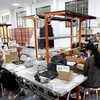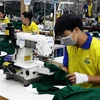 Farmers at a cooperative in the southern province of Ninh Thuan during a local meeting to discuss new production methods. (Photo: VNA)
Farmers at a cooperative in the southern province of Ninh Thuan during a local meeting to discuss new production methods. (Photo: VNA) According to Nguyen Van Thinh, Vice Chairman of the Vietnam Cooperative Alliance, as of the end of June 2023, there were a total of 30,425 cooperatives and 120,983 collaborative groups registered in the country, including 76,456 agricultural CGs.
He said improving regional connectivity is to play a crucial role in helping these cooperatives and collaborative groups operate more efficiently and gain advantages through economies of scale.
In order to realise such an objective, Thinh said it's high time cooperatives and collaborative groups broke away from the old and started embracing the ways of a knowledge-based economy, green economy, and environmental protection.
Top priorities for future development involves developing industries with high technological level, creating additional added value, and promoting the dynamism of industrial zones in line with the new growth strategy.
Ideally, he added, the country should establish industry clusters, which are to replace individual factories, enterprises and cooperatives that operate separately from one another.
The vice chairman said local governments must be at the forefront of making changes and providing support to businesses. It is essential to establish communication channels to promote coordination among local authorities, to enhance regional competitiveness, utilise resources to support regional linkage activities and projects, and to ensure sustainable socio-economic development of the region.
"Local leaders should regularly exchange and engage in dialogues with businesses, cooperatives and collaborative groups to understand their needs and difficulties," he said.
In addition, there is a need to establish a shared database on key products of different provinces, including requirements for scale, processes, quality standards, pricing, and product standards, which will facilitate supply chain coordination.
Tran Thi Hong Minh, Director of the Central Institute for Economic Management (CIEM), said Vietnam is facing both many opportunities and challenges in promoting regional linkages.
She said the global economy is forecast to continue on a recovery path, but there are still uncertainties and unpredictable developments. As the country actively pushes for greater international integration and continues to engage in regional and international collaboration efforts, economic cooperation, including with foreign partners, will likely see a new height in the near future. This will provide many opportunities for cooperatives and collaborative groups to participate in the global supply chain network.
"It is vital that in the coming years, localities across the country start building an interconnected supply chain and leveraging the advantages brought by economies of scale," she said.
She urged local governments and enterprises to start investing in measures to offset the adverse effects of climate change, as Vietnam has been said to be among some of the most affected. Climate change will likely pose numerous challenges for many regions across the country, and solutions will require collaborative efforts and coordination among local authorities.
"Climate change is a shared challenge, but it also produces a pressure to drive stronger regional linkages," she said.
Minh advised regions to start organising production models based on circular economy principles, which allow resource cycling and closed-loop processes, greater efficiency and are more environmentally friendly.
According to Hoang Anh Tuan, Deputy Director of the Domestic Market Department under the Ministry of Industry and Trade, economic development during the last few decades has raised numerous issues that cannot be solved by individual localities alone.
For example, he said major problems such as climate change and pollution can only be addressed when localities start putting resources, infrastructure, and scientific and technological knowledge together. He urged key economic regions to fully play their role as leaders and called for greater efforts to close the gap between developed and underdeveloped regions across the country.
Tuan stressed the importance of creating an effective network of regional production based on careful planning and development to help increase Vietnamese products’ competitiveness in the global market. He also advised local governments to start campaigns aiming at raising awareness of various benefits to be realised with an improved network of regional production such as increased trade of products, reduced oversupply and shortage, lower risks for farmers and faster adjustment to new market changes./.
VNA
